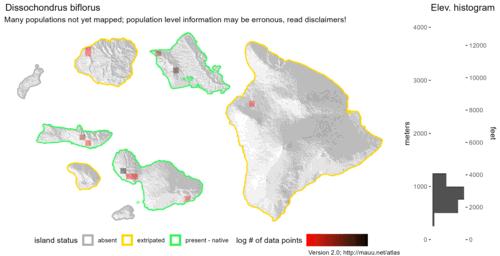Info
Subfamily: Panicoideae
Genus etymology: Dissochondrus = "double grain" [Greek] both florets are bisexual
Species etymology: biflorus = "twice flowered" [Latin] refering to two florets per spikelet
Photosynthetic type: C4 (warm season)
Nativity: endemic
Map

Plant

Spikelets




Description
Perennials with short, creeping, knotty rhizomes; culms 60-120 cm tall, compressed, branching intravaginally above base, puberulent at nodes. Sheaths glabrous, compressed-keeled, prolonged at apex into 2 membranous, deciduous auricles up to 6 cm long; ligule 1-2 mm long, pubescent, apex rounded to truncate, lacerate to fimbriate; blades flat, firm, 15-30 cm long, 1-2 cm wide, upper surface glabrous, lower surface scabrous, margins scaberulous toward apex, the apex gradually acuminate, contracted at base into a petiole. Inflorescences paniculate, narrowly cylindrical and spike-like, 10-20 cm long, somewhat loosely flowered with spacing between branches greater toward base, the branches short, appressed, the axis puberulent, solitary bristles usually present below each spikelet, the bristles green, S-10 mm long, flexuous, antrorsely scabrous; spikelets 2.5-3 mm long, glabrous, apex acute; first glume broad, 0.8-1.5 mm long, 1/4-1/3 as long as florets, puberulent, faintly 0-3- nerved, apex obtuse, second glume 2.5-3.5 mm long, extending beyond the florets, 5- nerved, puberulent, apex acute; florets ovate to ovate-lanceolate, first floret slightly larger than second floret; lemma planoconvex, ca. 2 mm long, yellowish to white, coriaceous, glossy, apex minutely puberulent; palea similar to lemma in color and texture, flat, ovate, ca. 2mm long, margins inrolled, apex apiculate. Caryopsis glabrous, lenticular, remaining enclosed within the floret. [2n = 36*.]
(Description source: O’Connor, P.J. 1990. Poaceae, pp. 1481–1604. In: Wagner W.L., Herbst D.R. & Sohmer S.H. (eds.)., Manual of the flowering plant of Hawaiʻi. Vol. 2. University of Hawaii Press & Bishop Museum Press, Honolulu )